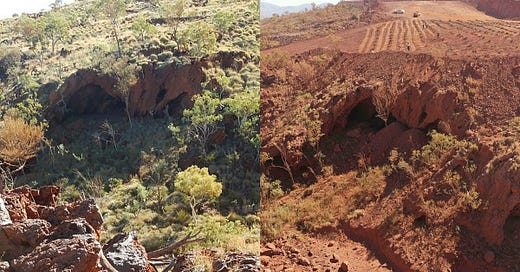The backlash after a sacred site demolition is set to redesign mining laws
Energy tech needs iron. This mine blew up a sacred site.
Hi! I’m Ian Morse, and this is Green Rocks, a newsletter that doesn’t want dirty mining to ruin clean energy.
Last week, we highlighted a Rio Tinto mine proposal in Arizona that threatens to destroy a sacred site of the San Carlos Apache, if it is approved this month.
This week, an Australian parliament committee called for a halt to destroying cultural sites after it found Rio Tinto’s demolition of a cultural site was “inexcusable.”
The committee released yesterday its first report from the investigation into the company’s destruction of Juukan Gorge that ignited international backlash.
Their report begins: “Never again can we allow the destruction, the devastation and the vandalism of cultural sites as has occurred with the Juukan Gorge—never again!”
In May, Rio Tinto blew up an Aboriginal heritage site that the company itself had called of “the highest archaeological significance in Australia.” The group tasked with investigating how the incident happened recommended government ban mining at cultural sites until new laws could be passed.
Infrastructure redesign demands iron. It’s also one of the most abundant elements on earth. Australia produced last year more than a third of the world’s new iron. Iron is used for just about all construction. Skyscraping wind turbines and industrial geothermal plants need iron, not to mention the steel casing for batteries and electric car frames.
The Rio Tinto CEO and two other executives were forced to resign earlier this year, and global investors controlling $14 trillion warned mining companies that they would not invest in companies destroying Native sites.
A few noteworthy quotes from the report:
Rio Tinto’s role in this tragedy is inexcusable. Rio knew the value of what they were destroying but blew it up anyway.
[The Puutu Kunti Kurrama and Pinikura people] were let down by Rio Tinto, the WA government, the national government, their own lawyers, and Native Title Law.
The Western Australian legislation that enabled the destruction of Juukan Gorge is woefully out of date and poorly administered. Everyone accepts this.
Protecting Indigenous heritage should be a priority of all governments.
The destruction at Juukan Gorge has not just impacted on a small and discreet group of Traditional Owners in the middle of the Pilbara; it has robbed a significant piece of history from all Australians—from the world.


In addition to rewriting laws, the report recommends Rio Tinto pay restitution to the PKKP. Deanna Kemp of the Centre for Responsibility in Mining wrote in a piece in The Conversation:
Having been put on notice, global mining companies are bolstering their communities and cultural heritage teams. But it is not enough to just increase head count. Social specialists and Indigenous people must hold positions of authority and have influence internally to contain corporate self-interest.
Rio Tinto’s moratorium on mining the Juukan Gorge site ends next month. The committee recommends making it permanent and reconstructing the rock shelters. Rio Tinto currently has legal permission to destroy an additional 1,700 Aboriginal heritage sites.


The inquiry held 13 public hearings and received input from more than 140 miners, cultural specialists, and civil society groups. The committee also pressed two other large mining companies, BHP and Fortescue, and their cultural heritage policies, although the report focused on Rio Tinto.
Rio Tinto responded to the report, saying “We are committed to learning from this event to ensure the destruction of heritage sites of such exceptional archaeological and cultural significance never occurs again.”
Read the 60-page report here. The final report, expected toward the end of 2021, will more closely examine the role of Rio Tinto and WA Government in the destruction, and how current laws protect or ignore cultural sites around the country.
More in The Guardian, Financial Times, ABC News, SBS News, Wall Street Journal, Reuters
Eye on Industry
The EU — likely the second largest EV market in the next decade — is set to write requirements to force battery makers to meet recycling targets starting in 2030, giving them time to design batteries that will enable easier recycling. It’s one element of a number of likely updates to battery regulation to come on Thursday.
The US government said rodents, not humans, destroyed a rare wildflower at the site of a planned lithium mine in Nevada.
A Greenpeace investigation found that deep-sea mining is going forward with a regulatory authority unequipped to evaluate environmental impacts and with just three companies dominating most permits.
As Rio Tinto puts together an environmental impact assessment, locals in Serbia are already fearing that its planned lithium mine will contaminate water and soil.
Reads
≠ endorsement
Mining Billionaire Leaves a Dirty Task to His Successor (Bloomberg)
The curse of 'white oil': electric vehicles' dirty secret ( The Guardian)
Can We Go Green Without Plundering the Global South? (Novara Media)
How the road to renewables runs through mining (Politico)
For podcast listeners: Politico’s The Future of Resources: The Fight over Critical Minerals
Thanks for reading! I’m Ian Morse, and this is Green Rocks, a newsletter that doesn’t want dirty mining to ruin clean energy.
These topics are relevant to anyone who consumes energy. If you know someone like that, tell them to sign up!







